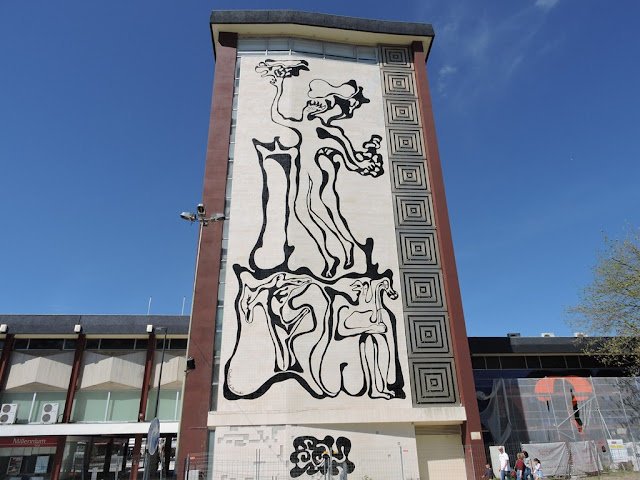VILA NOVA DE FAMALICÃO
41° 25' N; 8° 31' W
Vila Nova de Famalicão or Famalicão is a Portuguese city located in the sub-region of Ave, belonging to the North region and the district of Braga.
It is the seat of the Municipality of Vila Nova de Famalicão, which has a total area of 201.59 km2, 133,574 inhabitants in 2021 and a population density of 663 inhabitants per km2, subdivided into 34 parishes:
Antas e Abade de Vermoim;
Arnoso (Santa Maria e Santa Eulália) e Sezures;
Avidos e Lagoa;
Bairro;
Brufe;
Carreira e Bente;
Castelões;
Cruz;
Delães;
Esmeriz e Cabeçudos;
Fradelos;
Gavião;
Gondifelos, Cavalões e Outiz;
Joane;
Landim;
Lemenhe, Mouquim e Jesufrei;
Louro;
Lousado;
Mogege;
Nine;
Oliveira (Santa Maria);
Oliveira (São Mateus);
Pousada de Saramagos;
Pedome;
Requião;
Riba de Ave;
Ribeirão;
Ruivães e Novais;
Seide;
Vale (São Cosme), Telhado e Portela;
Vale (São Martinho);
Vermoim;
Vila Nova de Famalicão e Calendário;
Vilarinho das Cambas.
The highest point in the municipality is at Penedo das Letras, at an altitude of 468 meters.
Geography
Vila Nova de Famalicão is located in the province of Minho, in the district and archdiocese of Braga.
The city is located on an important road junction that connects it to Porto, Braga, Barcelos, Guimarães, Póvoa de Varzim and Santo Tirso. Both on a road and rail level, Vila Nova de Famalicão is a town with an excellent geographical location, which makes it a mandatory crossing point.
The city is 30 minutes from Francisco Sá Carneiro International Airport and the Port of Mar de Leixões, crossed by motorways, national roads and railways that link the main urban centers in the north of the country and Europe.
The region of Vila Nova de Famalicão has a Csb Mediterranean climate.
Devesa Park
Parque da Devesa was inaugurated on the 28th of September 2012 by the Mayor Armindo Costa, Vice-President Paulo Cunha and the rest of the Council, by the President of the Municipal Assembly Nuno Melo and by the Archbishop Primate of Braga D. Jorge Ortiga.
It is a recent work, but the first initiatives for its construction date back to 1988 with the Detailed Plan for the Area Adjacent to the Building of Lameiras. Until 2011, several plans/projects were approved, and in that same year, construction began.
It occupies an area of approximately 27 hectares and extends from Avenida General Humberto Delgado and Avenida do Brasil to the junction of the A3 and Santiago de Antas. It has an extensive network of pedestrian paths, on which families can enjoy walks or cycling; as well as large expanses of green areas that allow outdoor activities to be carried out, such as group classes in the gym, dance, karate, among others.
The rural constructions previously existing on the site were rehabilitated and transformed into cultural equipment and services such as the Casa do Território, Archeology Center, Cafeteria, Support Services and Educational Services. The Environmental Education unit implemented in the Educational Services will recover the Pelhe River, which is one of the most polluted in the municipality. It is possible to follow the evolution of the river, as well as other news on the park's facebook page or on the official page.
History
The historical remains on the origin of the settlement of this land, takes us to the Iron Age, more properly to archaeological remains of hillforts throughout the county.
Castro do Monte das Ermidas, perhaps founded in the 4th century BC, Castro de São Miguel-o-Anjo or Castro de Eiras, are some of the archaeological remains of remote settlements that the county has. The Pedra Formosa do Castro de Eiras, which belonged to a bathing complex, was discovered in 1880 and, according to archaeologists, it dates from the first millennium before Christ.
Geography
Vila Nova de Famalicão is located in the province of Minho, in the district and archdiocese of Braga, is the seat of the municipality and county, and is on flat ground at an altitude of 88 meters.
Famalicão is a tourist destination in Northern Portugal, enjoying a strategic location with fast links to the cities of Braga, Porto, Guimarães, Viana do Castelo, Barcelos, Santo Tirso and Vigo.
The city is 30 minutes from the international airport Francisco Sá Carneiro and the Leixões maritime port, crossed by highways, national roads and railways that unite the main urban centres of the North of Portugal and Europe.
The Vila Nova de Famalicão region has a Csb Mediterranean climate.
Economy
The economy of the municipality is mainly based on textile, automotive, metal-mechanic and agrofood industries, hosting the headquarters or branches of some large companies, such as Continental Mabor, Leica, Riopele, Vieira de Castro, and Primor.



































































